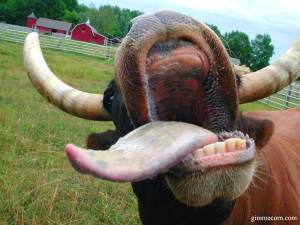I’m confused: is it the dust or the anus?
Or possibly both. Science is searching for answers to reduce the incidence of shiga-toxin producing E. coli.
One group of researchers did a longitudinal survey on three cattle herds known to be positive for, respectively, Enterohemorrhagic  Eschericia coli (EHEC) O157, O26/O103, and O26 in a slaughterhouse study. They found transmission and dissemination of EHEC might have occurred not only in the bovine reservoir but also in the farm environment and in other farm animals.
Eschericia coli (EHEC) O157, O26/O103, and O26 in a slaughterhouse study. They found transmission and dissemination of EHEC might have occurred not only in the bovine reservoir but also in the farm environment and in other farm animals.
In another study, researchers found in non-O157 STEC use novel adhesins, and not Intimin to adhere to bovine recto-anal junction squamous epithelial cells. These findings have important implications for the development of efficacious modalities for blocking adherence of non-O157 STEC to bovine gastrointestinal epithelial cells.
